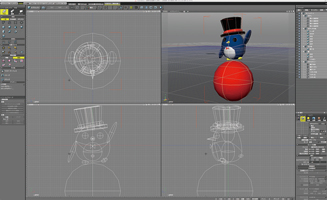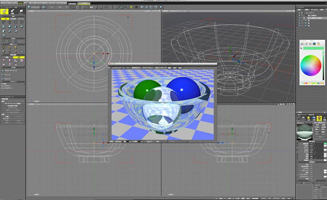|
Partly because of this background, Prof. Katsuraya took a doctorate while he was in Institute of Industrial Science, The University of Tokyo. When he moved to Wayo Women's University in the 2001 fiscal year, he was assigned to teach computer-related courses along with the field of chemistry. At present, for education of undergraduate courses he takes charge of 1) cultural studies subjects common throughout the whole university such as chemistry, science of color, and basics and application of Personal Computers; 2) specialized educational courses for Department of Fashion and Art such as fiber science, method for measuring apparatus, fiber science experiments, and computer graphics.
Meanwhile, Prof. Katsuraya also applied knowledge about ICT (information and communications technology) to the experiments that treat fiber materials as well as classes of measuring apparatus. Connecting all of PC's put on the tables of student groups with PC on the teacher's desk through Wi-Fi, he built up a two-way educational system. In this system, PowerPoint files that explain experimental operation or Excel files of assignment can be transmitted from the PC on the teacher's desk, or PC displays of all the students can be shared in real time and projected on the front screen. Furthermore, he realizes clarification of the teacher's intention and improvement in students' understanding by operating the optical microscope, electron microscope, spectroscopic system for infrared rays / ultraviolet rays / visible light, and High Performance Liquid Chromatography (HPLC), comparing their analysis results and indicating where they want students to look through a microscope at the same time.
Still more, responding to the request of students who seek for fair confirmation of attendance, Prof. Katsuraya explores use of biometrics authentication. Several years ago, he developed an attendance management system by applying a kit of the palm vein authentication system. This has cleared the problems so far completely, gaining a high reliability, says Prof. Katsuraya.
On the other hand, Prof. Katsuraya says, "The research topic as my lifework is synthetic chemistry using a variety of 'sugar'". In Functional Materials Chemistry Lab, he instructs graduate students about research with focus on fiber as clothing material through joint research with companies. Besides, as his own research, he is currently proceeding with joint research with other company and specialists of other fields within the Univ. about functional food that are expected to have effect to inhibit elevation of the blood sugar level as well as improve in high blood pressure.
In addition, Professor Katsuraya also takes charge of the teacher's license update courses conducted in the Univ. for the concerned teachers based on the teacher's license update system. He also serves as Director of University Education Center, of which mission according to him is "an organization equivalent to Division that guarantees the quality of education centering on subjects such as cultural studies, qualifications, and foreign languages".
Using Shade 3D for CG Subjects, to Strengthen Solid Feeling for Dressmaking
"In Dressmaking, what is interesting is that Japanese clothes are planar construction while Western clothes are solid construction."
In other words, while the kimono can be folded flatly, its planar (2D) cloth is made into a solid (3D) shape to fit the body, and fixed on the exquisite position using obi (sash). On the contrary, since Western clothes are ready-made in 3D (solid structures), it is hard to fold a dress flatly but easy to wear it. This is the difference between the two described frankly by Prof. Katsuraya. Taking draping in dressmaking as an example, he mentions the process of making solid pattern paper from planar paper. He says that this process is full of know-hows regarding solid structure science such as the comfortable feel to wear clothes.
|
Reflecting such backgrounds, when he examined opening of a course of "Computer Graphics" as a specialized educational course in the Department of Fashion and Art, he sought for ways as he "wanted to deal with 3D closely for the students to grasp the difference between 2D and 3D precisely if they start to study CG, as the feel of 3D is important for students." To understand the world of 2D and 3D, he thought, "in order to deal with three-dimensional things appropriately on the computer, only Photoshop and Illustrator are not enough. It can't be possible without using Shade, which creates structures while the top view, front view, and right-side view are compounded in mind." To develop the solid feel for dressmaking by grasping solid bodies with planes, he started the introductory education of CG for dressmaking using these three tools mentioned above.
In the class, first of all, students create CG of a snowman as the first experience of Shade3D. Second, as training for treating 3D appropriately, they challenge assignments such as "Draw a billiard ball and three crystal balls in a glass container like a bowl in a positional relationship so that the balls won’t sink each other." Finally, assignments develop into creation of CG of animals and application to 3D printing etc.
"When students are provided with a gadget of 3D (creation of CG), they learn how to use Shade3D while they watch and learn from models."
In addition, PCs and Shade3D themselves are becoming more and more highly efficient year by year. According to Prof. Katsuraya, its usability is steadily increasing for example, in that movement of images set by the preview rendering function of Shade3D can be confirmed in real time. Students specializing in dressmaking get interested in using Shade3D, absorbing the operation method in a sensible way to grasp it.
|
|
 |
 |
| Department of Fashion and Art provides a class of 3DCG using Shade3D |
|
Moreover, MEXT introduced the teacher's license update system in 2009. It is compulsory for teachers to take the training course of updating teacher's license for more than 30 hours within the period of 2 years in every 10 years to learn the latest and required knowledge and technique for the purpose of maintaining the validity of the license. To follow this, multiple update courses are provided in the University. As part of them, Prof. Katsuraya takes charge of the field related to information education. Among them, he has an impression that teachers use Shade3D as a tool to learn how to create 3DCG and are interested in it.
 |
|
|
|
|
| They contact the concept of solid structure required in learning digital fashion design through Shade3D |
Possibility of Future Utilization of Shade3D in Research
"Although I don't make technical materials regarding my research directly with Shade3D, I sometimes create objects of 3DCG with Shade3D for presentation, and use them as the materials of explanatory information."
In the Lab, Prof. Katsuraya works on fiber as clothing material for instructing research of graduate students, and diverse fields such as functional food for his own study. In doing so, he uses highly specialized technical software programs for the computer chemistry field as a major tool for creating molecule models etc. Among them all, he talks about expectations for Shade3D in its possibility of future utilization, in that "it is important to consider the world of 3D at the molecule level" in the world of chemistry.
"I also want to study Shade3D more to create, for example, 3DCG animation of interaction between biomolecule and functional materials."
If it is made possible to express various phenomena that can be explained by chemistry not by conventional 2D drawings but 3D animation, it should become all the more persuasive. Prof. Katsuraya says that he would like to lead this to development of teaching materials that can be used to explain for the students in class.
|
Seeing 125th Anniversary of Foundation in 2022,
Wayo Women's University Harmonizes Tradition and Innovativeness
Wayo Women's University
|
Wayo Women's University is originated in "Wayo Sewing Women's Institute", a vocational school for sewing (kimono and Western dressmaking) founded in 1897 at Fujimi, Chiyoda-ku, Tokyo. After Kudan school building was destroyed by fire by war damage, Wayo Women's Vocational School (at that time) moved to current Konodai Campus (Ichikawa-shi, Chiba) in 1946. After postwar educational system reform, in 1949, it started as current Wayo Women's University having School of Home Economics composed of Departments of Human Life Studies and Clothing.
After that, through expanding and reorganizing the organization, it has steadily established a presence as a traditional women's university. At the same time, it adopts a motto of practicing women's education that always meets the needs of time. As part of this, it has tried to develop fascinating organization of Departments for students.
|
|
The Univ. is currently organized by 4 Faculties of undergraduate shool: 1) Faculty of Humanities composed of Department of Japanese Literature and Culture, Department of Psychology, and Department of Child Development and Education; 2) Faculty of Human Ecology composed of Department of Fashion and Art, Department of Health and Nutrition, and Department of Home Economics and Social Welfare; 3) Faculty of Nursing (established in April 2018), and 4) Faculty of Global Studies (newly established in April 2020 after former Department of Global Studies, Faculty of Humanities had become independent); and 2 Divisions (of Humanities and Human Ecology) of graduate schools. The Univ. has about 2,900 students (as of May 2019) in total for both undergraduate and graduate schools in total.
|
|
 |
|
The Konodai campus accommodates the Univ. and Wayo Konodai Girl's Junior High and High Schools. Along with Wayo Kudan Girl's Junior High and High Schools, situated in the site where the former Kudan school buildings of the Univ. previously stood, they compose the Wayo Gakuen School Corporation that sees the 125th anniversary of foundation in 2022.
It takes about 8 minutes by bus from JR Ichikawa Station treading
its way through the urban area. In the Konodai Campus, which
has just finished substantial renewal for that continued
about 20 years, the school buildings in brick color are
efficiently arranged. Harmonizing with the rows of cherry
blossom trees that were developed accordingly, they bring
about clean and calm atmosphere.
|
|
|